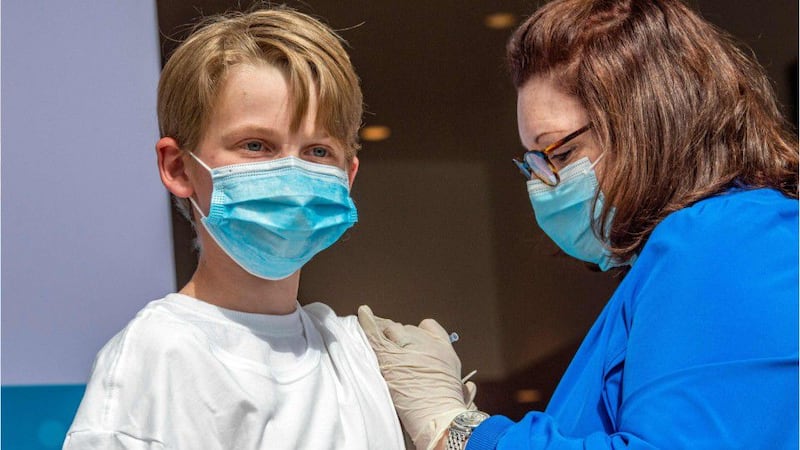ORLANDO, Fla. — When the school year started in August, Anacelia Deluna wasn’t sure if she should send her son into the classroom.
She is a full-time mother who feared he would bring COVID-19 into their home, where she also cares for her older daughter.
Read: State of Florida files lawsuit against Biden administration over COVID-19 vaccine mandates
“I have a daughter who cannot undergo anymore heart surgeries,” Deluna said, fighting back tears.
She took a chance anyway because she also worried that keeping her 6-year-old out of the classroom would set him back academically and socially.
The isolation since the start of the pandemic has been tough.
Weeks into the new school year, her son tested positive for COVID-19.
“I was in line at the bank making a deposit, and I get a call from the district telling me that my son had been exposed to a positive case of COVID,” Deluna said.
Read: Fourth COVID-19 shot may be needed for immunocompromised, CDC says
The thought of how it would impact her family was heartbreaking.
“I literally broke down in the vehicle. I felt like a failure. I felt like I had just failed my daughter,” she said.
9 Investigates started researching pediatric COVID-19 cases during the summer as more local children were hospitalized with this virus.
For months, we were easily able to track the data using a dashboard maintained by the Florida Department of Health. It produced detailed daily case totals broken down by county, ages, race and gender.
But in June, the state stopped producing and publicly releasing the data daily.
Florida Gov. Ron DeSantis determined that it was unnecessary because case counts were starting to decline.
The state then started releasing weekly reports offering only statewide data.
9 Investigates previously reported that the state also stopped providing detailed information on cases to each county.
We continued to track pediatric cases using the statewide weekly reports while monitoring trends as researchers continued to work on developing a vaccine suitable for emergency use authorization for children under 12.
Watch the full story here:
Infections increase in children under 12 by the week and for the first several weeks of the new school year, which began in August.
“A lot of people virtual schools (last year), everyone had extra barriers, everyone was good about wearing their mask. And then we laxed on those because a lot of people were vaccinated,” said Dr. Adriana Cadilla, of Nemours Children’s Hospital. “If you’re vaccinated, you’re protected. But we forgot that the kids weren’t protected, and we sent them back to school. And they’re doing all these sports, which they need to do, but we saw significant changes.”
Cases started slowly declining in September, coinciding with the rise in those 12 and up getting vaccinated, and as researchers worked to find the right dose of the vaccine for those aged five to 11.
Investigative reporter Daralene Jones asked Cadilla how the pediatric vaccine is different from the one for adults.
“It’s the same vaccine per se. It’s just a smaller dose,” Cadilla said. “Kids will be getting a third of the dose, also getting it 21 days apart. It’s the same makeup of the vaccine that we’ve been studying for well over a year that millions of people have had with multiple inquiries, research, safety.”
Allison Aubuchon, a mother of three, said that she might consider getting her children vaccinated only if they were to plan an international trip.
“I don’t think there’s enough research on it, whether it’s the younger kids’ age or people like myself,” she said. “If you get the vaccine, that doesn’t mean you’re not going to get it. (It) just prevents you from being on a ventilator, prevents you from dying.”
Read: Dozens of Florida entities under review for violating state ‘vaccine passport’ ban
Pfizer’s clinical trial did not focus on the vaccine’s ability to prevent the virus or hospitalizations, but rather how many antibodies develop to fight COVID-19.
The initial trial enrolled as many as 4,500 children aged 6 months to 11 years old from the United States, Finland, Poland and Spain and involved more than 90 clinical trials.
The final research was based on more than 2,000 children who participated, although regulators wanted to see at least 3,000 children in the study as more than 44,000 participants were involved in the adult study.
“Kids, I believe, make up about 22.5% of the population in the United States, so they are a smaller number,” Cadilla said. “There are so many drugs that are approved for adults, but there are just not enough kids for trials to occur. So a lot of times we still do extrapolate data from adults and use it (for) off-label use or EUA to treat children.”
Aubuchon said she worries about the lack of research and the potential long-term impacts on people.
Read: Coronavirus: Traces of Mu variant found in Altamonte Springs wastewater
“We just don’t know what could happen,” she said. “In six months, a year, two years, five years from now, are we going to have repercussions from it?”
Some doctors insist that convincing concerned parents to vaccinate their children is still key to getting the virus under control.
It’s proven that children can transmit the virus at a higher rate because they’re often exposed more often to larger groups of people, including school and day care.
Deluna said she believes her son contracted COVID-19 from his teacher, who tested positive days before him.
“He didn’t have symptoms until seven days after he tested positive,” she said.
She said she will be in line to get the vaccine because her daughter’s health depends on it.
Deluna said her son is doing his schoolwork from home until the vaccine is mandated for children.
“I might have to see her die because of somebody’s irresponsibility or somebody’s refusal to take a vaccine that could save their lives plus my daughter’s,” Deluna said. “She’s only 16 years old.”
There are seven other vaccines mandated for school or day care enrollment, including polio, measles, mumps, chicken pox and hepatitis.
The FDA requires pharmaceutical companies to do follow up research once the vaccine roles out to track adverse effects and effectiveness in the larger population.
That is factored in prior to full approval, which could lead to a mandate.
Click here to download the free WFTV news and weather apps, click here to download the WFTV Now app for your smart TV and click here to stream Channel 9 Eyewitness News live.


















